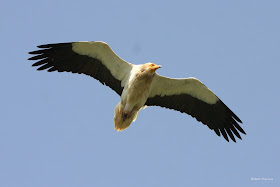 |
| Egyptian Vulture |
This is the first of two posts about our trip to Israel. We spent our first week in the northern part of the country. Northern Israel (north of Jerusalem) is markedly different from southern Israel. Whereas the south is dominated by desert ecology, northern Israel has more variety. Overall, many areas in the north are still quite dry, but there are some moister environments and naturally occurring fresh water is more plentiful.
 |
| Spur-winged Plover |
Our trip planning was very much influenced by a set of two bird finding guides by Hadoram Shirihai (one volume for northern Israel, and one for the south). Although these guides are now somewhat dated, and some of the locations mentioned are perhaps not as productive as they once were, overall these books were indispensible to us.
There is a lot of aquaculture in northern Israel, and we became quite accustomed to birding the fish ponds of northern Israel. Not only do these ponds attract many of the birds that you would associate with water (e.g. waders, kingfishers, gulls) but also there were many passerine birds to be found in these habitats. Strangely, we observed a low diversity of ducks in northern Israel, except at Agamon Hula where we had a nice variety, the rarest of which was a Marbled Teal.
Speaking of Agamon Hula, this is the place that is situated in the Hula Valley that due to some careful management and environmental remediation, attracts tens of thousands of Common Cranes during both the northbound spring migration and the southbound fall migration. The peak migration of these Cranes occurred before we arrived, however we still obeserved a few thousand of them.
 |
| White-throated Kingfisher |
Our experience in the Golan Heights is best characterized by the raptors we saw there. In particular, Gamla Nature Reserve was fabulous for up close looks at Steppe Buzzard, Short-toed Eagle, Egyptian Vulture and Griffon Vulture some of which breed in the wadis. This location was also good for Woodchat Shrike and Southern Grey Shrike, Sardinian Warbler and Corn Bunting among others.
With the help of the Shirihas guide books we were quite successful birding on our own in this region. We did meet one person at Agamon Hula who provided some helpful information about the birds there and confirmed some of our sightings for us.
Stay tuned for part II: Southern Israel.
